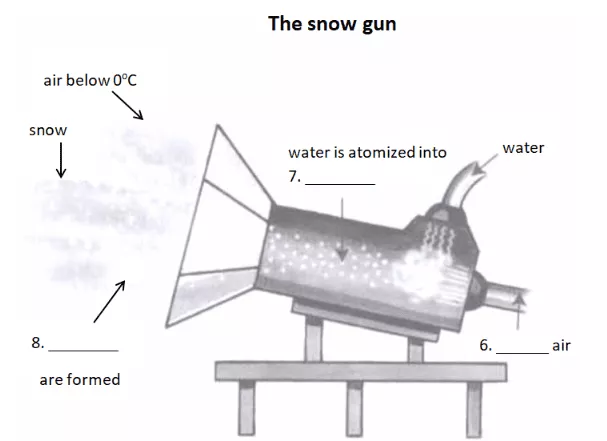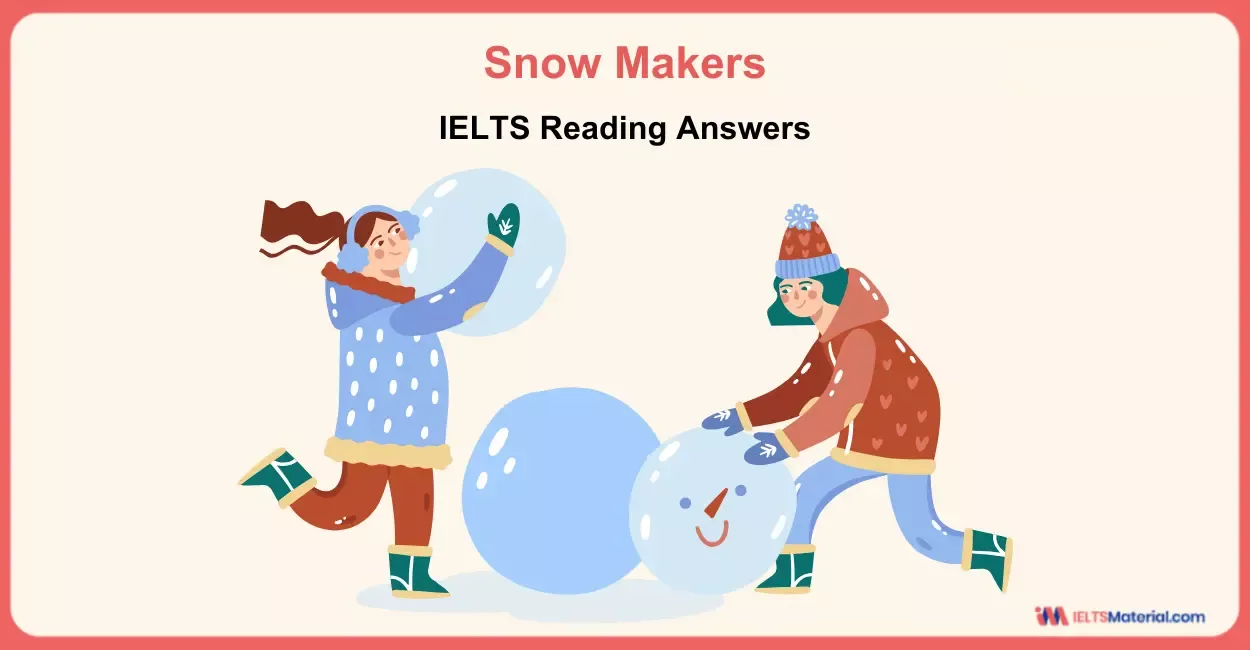Snow Makers - IELTS Reading Answers
14 min read
Updated On
-
Copy link
Get familiar with the common mistakes to avoid when attempting the IELTS Reading passage on ‘Snow Makers’. Check out different question types, tips, and answers with explanations to improve analysis, detail recognition, and logical reasoning.
Table of Contents

Limited-Time Offer : Access a FREE 10-Day IELTS Study Plan!
The Academic passage ‘Snow makers’ is a reading passage that appeared in an IELTS Test. This topic would help you get the main idea through skimming, the technical details through scanning, and the specific vocabulary in context. With practice, you'll gain the knowledge to tackle the questions provided in the passage faster and in a more accurate way. However, you must attempt answering first before diving into the answer key of the IELTS Reading passage. This evaluation will improve your skills and help you work on the areas of improvement to achieve a band 8+.
Connect with our band 9 IELTS Trainers to crack your IELTS Reading in no time! Book a FREE Demo.
Types of Questions in IELTS Reading Passage ‘Snow Makers’
Having an understanding of question types is crucial before you start reading the passage or even start answering. In this way, you will develop a more tactical reading of the text, leading to easy information retrieval and finding answers for each question with confidence. The following are the different types of questions which you will need to answer for the passage, ‘Snow Makers’.
- IELTS Reading Matching Headings [Q.1 - Q.5]
- IELTS Reading Diagram Completion [Q.6 - Q.8]
- IELTS Reading Sentence Completion [Q.9 - Q.13]
Common Mistakes to Avoid in IELTS Reading Passage ‘Snow Makers’
The passage on ‘Snow Makers’ will help you with detailed comprehension skills but at times, you might make mistakes while finding the correct answer. This is due to the facts, processes, and technical descriptions which makes the passage seem difficult and your IELTS Band Score could be affected. However, to avoid making these common mistakes related to the three question types, it is necessary to get familiar with these errors to avoid them in the future. Below are some of the mistakes which can help you to improve your reading skills and build your confidence while answering.
|
Question Types |
Mistakes |
Strategies to Avoid |
|
Matching Headings |
|
|
|
Diagram Completion |
|
|
|
Sentence Completion |
|
|
Want to learn how to answer IELTS Reading Diagram Completion? Check out the video below!
IELTS Reading Passage on ‘Snow Makers’
Read the text below and answer Questions 1-13.
Snow-makers
Skiing is big business nowadays. But what can ski resort owners do if the snow doesn't come?
A In the early to mid twentieth century, with the growing popularity of skiing, ski slopes became extremely profitable businesses. But ski resort owners were completely dependent on the weather: if it didn't snow, or didn’t snow enough, they had to close everything down. Fortunately, a device called the snow gun can now provide snow whenever it is needed. These days such machines are standard equipment in the vast majority of ski resorts around the world, making it possible for many resorts to stay open for months or more a year.
B Snow formed by natural weather systems comes from water vapour in the atmosphere. The water vapour condenses into droplets, forming clouds. If the temperature is sufficiently low, the water droplets freeze into tiny ice crystals. More water particles then condense onto the crystal and join with it to form a snowflake. As the snow flake grows heavier, it falls towards the Earth.
C The snow gun works very differently from a natural weather system, but it accomplishes exactly the same thing. The device basically works by combining water and air. Two different hoses are attached to the gun. One leading from a water pumping station which pumps water up from a lake or reservoir, and the other leading from an air compressor. When the compressed air passes through the hose into the gun, it atomises the water - that is, it disrupts the stream so that the water splits up into tiny droplets. The droplets are then blown out of the gun and if the outside temperature is below 0°C, ice crystals will form, and will then make snowflakes in the same way as natural snow.
D Snow-makers often talk about dry snow and wet snow. Dry snow has a relatively low amount of water, so it is very light and powdery. This type of snow is excellent for skiing because skis glide over it easily without getting stuck in wet slush. One of the advantages of using a snow-maker is that this powdery snow can be produced to give the ski slopes a level surface. However, on slopes which receive heavy use, resort owners also use denser, wet snow underneath the dry snow. Many resorts build up the snow depth this way once or twice a year, and then regularly coat the trails with a layer of dry snow throughout the winter.
E The wetness of snow is dependent on the temperature and humidity outside, as well as the size of the water droplets launched by the gun. Snow-makers have to adjust the proportions of water and air in their snow guns to get the perfect snow consistency for the outdoor weather conditions. Many ski slopes now do this with a central computer system that is connected to weather-reading stations all over the slope.
F But man-made snow makes heavy demands on the environment. It takes about 275,000 litres of water to create a blanket of snow covering a 60x60 metre area. Most resorts pump water from one or more reservoirs located in low-lying areas. The run-off water from the slopes feeds back into these reservoirs, so the resort can actually use the same water over and over again. However, considerable amounts of energy are needed to run the large air-compressing pumps, and the diesel engines which run them also cause air pollution.
G Because of the expense of making snow, ski resorts have to balance the cost of running the machines with the benefits of extending the ski season, making sure they only make snow when it is really needed and when it will bring the maximum amount of profit in return for the investment. But man-made snow has a number of other uses as well. A layer of snow keeps a lot of the Earth’s heat from escaping into the atmosphere, so farmers often use man-made snow to provide insulation for winter crops. Snow-making machines have played a big part in many movie productions. Movie producers often take several months to shoot scenes that cover just a few days. If the movie takes place ina snowy setting, the set decorators have to get the right amount of snow for each day of shooting either by adding man-made snow or melting natural snow. And another important application of man-made snow is its use in the tests that aircraft must undergo in order to ensure that they can function safely in extreme conditions.
Questions 1-5
Reading Passage 1 has seven paragraphs A-G.
Choose the correct heading for each paragraph from the list of headings below.
Write the correct number (i-x) in boxes 1-5 on your answer sheet.
|
List of headings
|
1 Paragraph C .................................
2 Paragraph D .................................
3 Paragraph E .................................
4 Paragraph F .................................
5 Paragraph G .................................
Questions 6-8
Label the diagram below using NO MORE THAN TWO WORDS from the passage for each answer. Write your answers in boxes 6-8 on your answer sheet.

Questions 9-13
Complete the sentences below.
Choose NO MORE THAN THREE WORDS from the passage for each answer. Write your answers in boxes 9-13 on your answer sheet.
Dry snow is used to give slopes a level surface, while wet snow is used to increase the 9 .......................... on busy slopes.
To calculate the required snow consistency, the 10 .......................... of the atmosphere must first be measured.
The machinery used in the process of making the snow consumes a lot of 11 .......................... which is damaging to the environment.
Artificial snow is used in agriculture as a type of 12 .......................... for plants in cold conditions.
Artificial snow may also be used in carrying out safety checks on 13 ..........................
Join our IELTS online classes for expert guidance. Sign up today!
Answers with Explanation on IELTS Passage ‘Snow Makers’
The answers for the passage ‘Snow Makers’ are presented in the table below along with explanations for each question. Always self-assess your performance and note down the frequent errors which are reducing your overall band scores. With consistent practice, you will be able to develop skills and score a band 8+.
Unlock Answers
| Question number | Answer | Explanation |
|---|---|---|
| 1 | ix | Paragraph C explains how the snow gun (artificial) ‘works differently’ from a ‘natural weather system’, but it accomplishes exactly the same thing. The ‘device basically works by combining water and air’. ‘Two different hoses’ are attached to the gun – one ‘leading from a water pumping’ station which pumps water up from a lake or reservoir, and the other ‘leading from an air compressor’. When the ‘compressed air passes through the hose’ into the gun, it ‘atomises the water’ – that is, it disrupts the stream so that the water splits up into tiny droplets. The ‘droplets are blown out of the gun’ and if the ‘outside temperature is below 0°C, ice crystals will form’, and will then make ‘snowflakes same as natural snow’ (natural product).
Hence, the answer is ix (Artificial process, natural product). |
| 2 | iii | Paragraph D refers to the two types of snow – dry snow and wet snow. ‘Dry snow has a relatively low amount of water’, so it is ‘very light and powdery’. This type of snow is ‘excellent for skiing’ (need of dry snow) because skis glide over it easily without getting stuck in wet slush. One of the ‘advantages’ of using a snow-maker is that this powdery snow can be produced to ‘give the ski slopes a level surface’ (need of dry snow). However, ‘on slopes which receive heavy use’ (use of wet snow), ‘resort owners also use denser, wet snow underneath the dry snow’. Many resorts ‘build up the snow depth’ this way once or twice a year, and then regularly coat the trails with a layer of dry snow throughout the winter. Hence, the answer is iii (The need for different varieties of snow). |
| 3 | viii | Paragraph E states that the wetness of snow is dependent on the temperature and humidity outside, as well as the size of the water droplets launched by the gun. Snow-makers have to adjust the proportions of water and air in their snow guns to get the perfect snow consistency for the outdoor weather conditions. Many ski slopes now ‘do this with a central computer system’ (new method) that is ‘connected to weather-reading stations’ all over the slope. Hence, the answer is viii (New method for calculating modifications). |
| 4 | i | Paragraph F reveals that ‘man-made snow’ makes ‘heavy demands on the environment’. It takes about ‘275,000 litres of water’ to ‘create a blanket of snow covering a 60×60 metre area’ (wastage of water). Moreover, ‘considerable amounts of energy’ are needed to ‘run the large air-compressing pumps’, and the ‘diesel engines’ which run them also ‘cause air pollution’. Hence, the answer is i (Considering ecological costs). |
| 5 | vi | Paragraph G points out that ‘man-made snow’ has a ‘number of other uses’ as well. A layer of snow keeps a lot of the Earth’s heat from escaping into the atmosphere, so ‘farmers’ often use ‘man-made snow to provide insulation for winter crops’. Secondly, ‘snow-making machines have played a big part in many movie productions’. Movie producers often take several months to shoot scenes that cover just a few days. If the movie takes place in a snowy setting, the set decorators have to get the right amount of snow for each day of shooting either by adding man-made snow or melting natural snow. ‘Another important application of man-made snow’ is its ‘use in the tests that aircraft must undergo’ in order to ‘ensure’ that they can ‘function safely in extreme conditions’. Hence, the answer is vi (Applications beyond the ski slopes). |
| 6 | compressed | Paragraph C describes how the snow gun works very differently from a natural weather system. The ‘device basically works by combining water and air’. ‘Two different hoses’ are ‘attached to the gun’ – ‘one leading from a water pumping station which pumps water up from a lake or reservoir’, and the ‘other leading from an air compressor’ (which carry compressed air as marked in the diagram). When the ‘compressed air’ passes through the hose into the gun, it atomises the water. Hence, the answer is ‘compressed’. |
| 7 | (tiny) droplets | Paragraph C tells that the snow gun basically works by combining water and air. Two different hoses are attached to the gun – one leading from a water pumping station which pumps water up from a lake or reservoir, and the other leading from an air compressor. When the compressed air passes through the hose into the gun, it ‘atomises the water’ – that is, it disrupts the stream ‘so that the water splits up’ into ‘tiny droplets’. The ‘droplets’ are blown out of the gun. Hence, the answer is (tiny) droplets. |
| 8 | Ice crystals | Paragraph C informs that the snow gun works by combining water and air. When the compressed air passes through the hose into the gun, it ‘atomises the water’ – that is, it disrupts the stream so that the water ‘splits up into tiny droplets’. The droplets are then blown out of the gun and ‘if the outside temperature is below 0°C’, ‘ice crystals’ will form, and will then make snowflakes in the same way as natural snow. Hence, the answer is ice crystals. |
| 9 | Depth | Paragraph D refers to an advantage of using a snow-maker which is that ‘this powdery snow’ (dry snow) can be produced to ‘give the ski slopes a level surface’. However, ‘on slopes which receive heavy use’ (busy slope), resort owners also ‘use denser, wet snow’ underneath the dry snow. Many resorts ‘build up’ (increase) ‘the snow depth’ this way once or twice a year, and then regularly coat the trails with a layer of dry snow throughout the winter. Hence, the answer is depth. |
| 10 | Temperature and humidity | Paragraph E brings forward the fact that the ‘wetness of snow’ is ‘dependent on the temperature and humidity outside’ (temperature and humidity are measured first), as well as the size of the water droplets launched by the gun. Snow-makers have to adjust the proportions of water and air in their snow guns ‘to get the perfect snow consistency’ for the outdoor weather conditions. Hence, the answer is temperature and humidity. |
| 11 | Energy | Paragraph F reveals that ‘man-made snow’ makes ‘heavy demands on the environment’ (damaging to environment). Considerable ‘amounts of energy’ are ‘needed to run’ (consume) the ‘large air-compressing pumps’ (machinery used in the process of making snow). Hence, the answer is energy. |
| 12 | Insulation | In paragraph G, it is mentioned that a layer of snow keeps a lot of the Earth’s heat from escaping into the atmosphere. So, ‘farmers’ (people related to agriculture) often ‘use man-made snow’ (use artificial snow) to ‘provide insulation’ for ‘winter crops’ (crops in winter). Hence, the answer is insulation. |
| 13 | Aircraft | Paragraph G recognises another important application of ‘man-made snow’ (artificial snow) is its ‘use in the tests’ that ‘aircraft must undergo’ in order to ‘ensure’ (carry out safety checks) that they can ‘function safely in extreme conditions’. Hence, the answer is aircraft. |
Join our IELTS webinars to learn master tips for the Reading section! Click here to explore!
Strengthening your analytical skills to spot important aspects and understanding how to attempt different question types in the IELTS Academic Reading section is crucial. From the passage on ‘Snow Makers’, you will be able to note the areas of improvement and focus on individual question types and their specific strategies. Keep practicing consistently and focus on these skills to enhance them which will eventually improve your performance.
Check More IELTS Reading Answers
Also check :
Practice IELTS Reading based on question types

Start Preparing for IELTS: Get Your 10-Day Study Plan Today!
Explore other Reading Practice Tests

Kasturika Samanta

Nehasri Ravishenbagam

Nehasri Ravishenbagam
Recent Articles

Nehasri Ravishenbagam

Haniya Yashfeen

Haniya Yashfeen

Haniya Yashfeen





Post your Comments